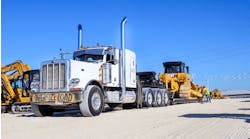Between higher fuel prices and added weight on new vehicles as a result of heavier emissions control equipment, truck operators have become more weight conscious than ever when specifying components. For many fleets, new, lighter-weight fifth wheels could be the right choice.
Greg Laarman, Jost International's vp-engineering, says there are three general approaches to weight reduction in fifth wheels. The first is to use material more efficiently. The second is to have one component serve more than one function in the design. The third is to use less material by substituting higher-strength materials.
“Weight-reduced fifth wheel products can be suitable for all applications provided one or all of these three approaches are used to maintain adequate system strength,” Laarman states. “Jost utilizes all of these techniques to meet current demands for fleet vehicle weight savings.”
A good example is “the fifth wheel top plate casting, where Jost's creative combination of ribs and the assembly of multiple parts working together create a more efficient design.” Also, compared to sliding fifth wheels that use an outboard slider, which requires a separate mounting angle be added to the structure's design to facilitate mounting to the tractor frame, the Jost inboard slider “uses the mounting angle as the only structural component holding the slider together. This dual function can result in a weight savings of over 100 lbs.,” Laarman reports.
HUGE WEIGHT SAVINGS
Laarman notes that all Jost sliders are manufactured from 80,000 psi minimum yield materials, compared to some others rated 36,000 psi. Use of the higher-strength material in place of more materials of a lesser strength results in huge weight savings for Jost products, he explains.
“When evaluating new equipment specification changes to accomplish weight savings, it's important to keep in mind that some weight-sensitive applications have tough fifth wheel requirements,” Laarman points out. “For example, a light duty top plate may not last on a torsionally rigid tank trailer that must negotiate city streets every day.”
Also, before specifying a component due to weight alone, he says a fleet should determine how safe the product is. The Jost JSK36 Series top plates offer a 20-lb. savings over the manufacturer's JSK37 Series, yet keeps the exact same locking mechanism to ensure safe couplings.
Rich Carroll, vp-sales and marketing for Jost, says the company has released a new, safe coupling device called Locktronic, which features a self-contained, battery-powered sensor that emits a bright flashing light right at the release handle opening of the fifth wheel when it's safely locked. “We see this as a logical first step towards more sophisticated automated coupling and monitoring systems that will become the standard in the future.”
INDUSTRY'S LIGHTEST FIFTH WHEEL
SAF-Holland's vp-product planning and market development, Mike Ginocchio, says three Holland products introduced over the last several years are aimed specifically at helping fleets reduce weight. The most recent is the FWAL aluminum top plate fifth wheel. An average of 100 lbs. lighter than other standard fifth wheel products, the FWAL is the lightest in the industry, he reports.
To produce that result, SAF-Holland partnered with Alcoa Aluminum Products, which manufactures the forged aluminum top plate for the new fifth wheel. The FWAL is available at both the OEM and fleet level, as well as in the aftermarket for fleets weight-sensitive enough to justify doing a conversion, Ginocchio points out.
“All types of fleets can use this product, assuming they are running trucks within legal weight limits and are for the most part on-highway operations. The FWAL has the same [strength and durability] ratings as our other standard non-aluminum top plate fifth wheels.” It is, however, more expensive, so it tends to make the most sense for fleet applications like high-cost chemical haulers and other kinds of liquid bulk transporters that could benefit from having the ability to add more product per load.
“For fleets that want a reduced weight fifth wheel but can't get the payback from an FWAL model, we offer the FW17. Introduced four years ago, this product provides a 40-lb. weight savings over other major fifth wheels we offer. It has a patented locking mechanism with only four moving parts to help reduce weight as well,” says Ginocchio.
The third lightweight Holland product is the ILS (Integrated Low-Weight Slider) mounting bracket system. Sliding fifth wheel brackets, according to Ron Froese, director of powered vehicle OEM sales, account for nearly 70% of the market. As opposed to stationary fifth wheels, they allow fleets the flexibility to move the fifth wheel forward and back on the tractor frame, depending on how they want to distribute the load.
Fleets using the lightweight ILS system, Froese reports, can save anywhere from 30 to 120 lbs. per fifth wheel over the previous Holland slider system, depending on configuration. Because it's more flexible, the ILS also offers fleets a better resale value than fixed mounting systems.
Froese says the company expects most OEMs who have not already installed the ILS mounting bracket on their vehicles to do so this year. “Our objective in all our design projects is to maintain the strength, structural integrity and durability of the product,” he adds. “In fact, it's a requirement of ours.”
Ginocchio notes a combination of improved engineering technologies and improved casting and forging suppliers who are taking advantage of new technologies on the market has enabled the fifth wheel manufacturer to reduce the weight of its products while maintaining strength and reliability.
Fontaine International says it has over a half dozen ongoing development projects targeting weight reduction, including programs with each of its major OEM customers. Product launches vary from early 2009 to 2012. The fifth wheel systems will have reduced weights from 75 to over 200 lbs.
Terry Mennen, vp-business development at Fontaine, notes the company has already introduced an air slide that provides a 40-lb. weight savings. The ATB slider utilizes a composite air cylinder that provides superior corrosion resistance in addition to being lighter weight, he explains.
“Arbitrarily reducing weight can create performance issues,” states Mennen. “With any new product release or modification, safety is the most important factor considered by the Fontaine International engineering team. We carefully validate the product at our testing facilities before it becomes available to the market. We also utilize OEM-approved proving grounds for durability testing and provide units for fleet evaluation prior to production release.”
A new product available from Fontaine is SmartLock, an in-cab electronic system that utilizes two sensors to let the driver know if the kingpin is correctly positioned in the lock to prevent false couplings. After coupling, the system monitors the sensors and warns the driver with a red light if a change occurs.
FOR MORE INFORMATION, VISIT THESE WEB SITES:
FONTAINE INTERNATIONAL
www.fifthwheel.com
JOST INTERNATIONAL
www.jostinternational.com
SAF-HOLLAND USA
www.safholland.com


